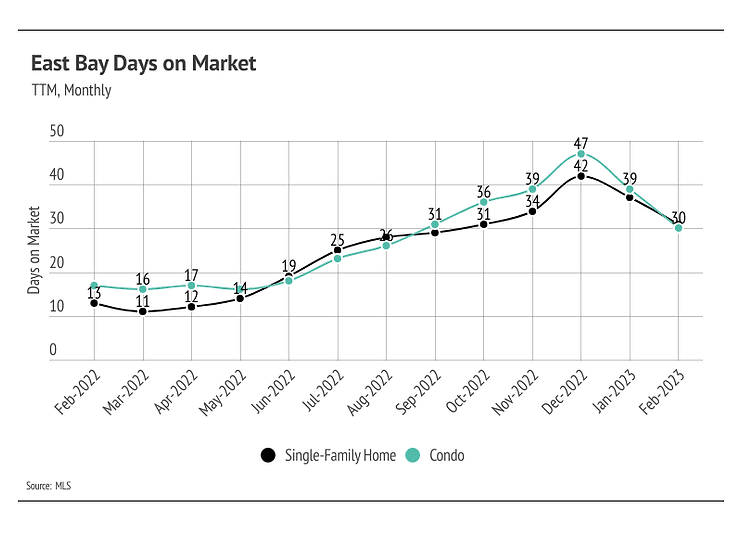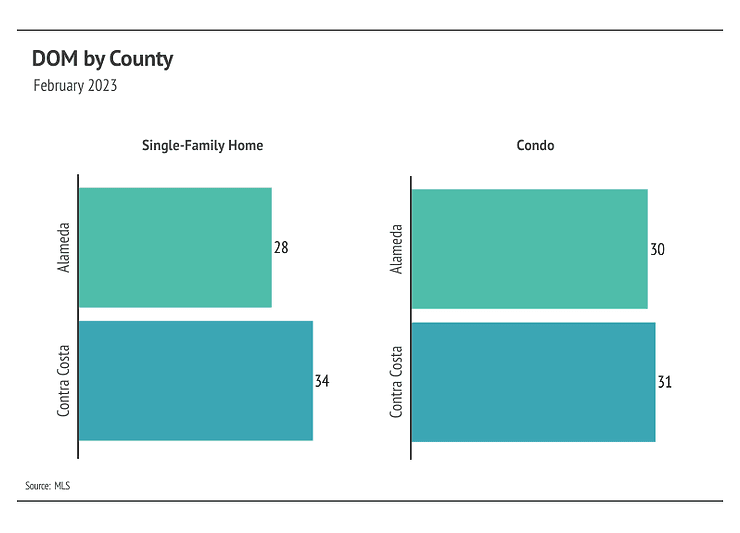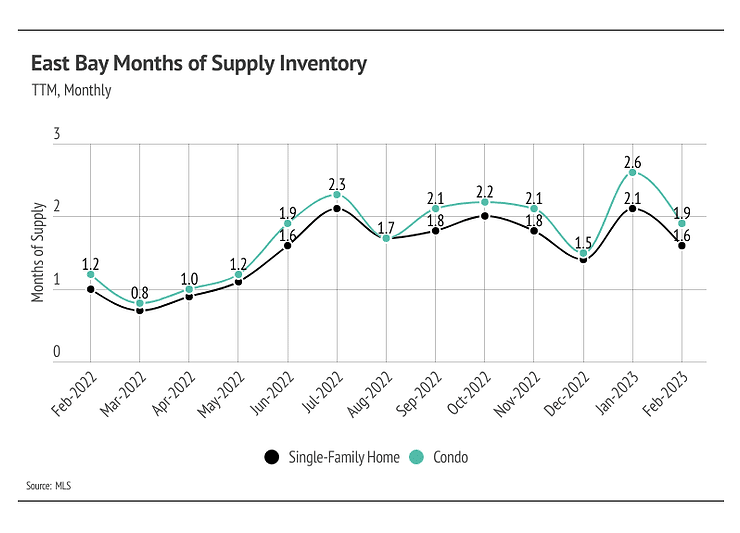
The Big Story
Mixed Signals
Quick Take:
- Home sales fell for the 12th month in a row, while, according to the National Association of REALTORS®, the median sale price continued its seven-month decline from its June 2022 peak. However, data from realtor.com indicate the median price per square foot rose slightly in January and February 2023.
- U.S. employment is booming, which largely alleviates our concerns that a full economic recession will occur anytime soon. Yet, consumer confidence is low, and increasing consumer credit card debt and delinquency are early signs of economic instability.
- Inflation and mortgage rates are still high, which has massively slowed the housing market, as buyers and sellers are still adjusting to the new market conditions.
Note: You can find the charts & graphs for the Big Story at the end of the following section.
Ins and Outs of A Housing Market Slowdown
Banking analysts and economists are starting to cry recession again, as the Fed is faced with a longer road than anticipated to lower inflation. Over the past year, the Fed has raised its benchmark rate by 4.5% and shrunk its balance sheet by over $600 billion. At a minimum, we expect the Fed to raise its target interest rates to 5.25% by the end of the year, which will only happen if they continue to raise rates by 0.25% over the next three quarters. There is a very real chance that rates will move higher than 5.25% because the Fed has such limited tools to combat inflation. The economy is still in the early days of disinflation — a temporary slowing of the pace of price inflation — and the Fed has indicated that they’ll keep rates high until inflation is under control. This uncertainty around interest rates has hit the housing market especially hard.
Mortgage rates have been volatile, making it more challenging for buyers in terms of financing and affordability. Historically, the spread between the 10-year U.S. Treasury Securities and 30-year mortgage rates has been around 1.8%. Currently, 10-year treasuries are yielding 4.08%, while the average 30-year mortgage rate is 6.65%, a spread of 2.57%. Buyers and sellers are still getting used to the dramatic mortgage rate hikes that started in early 2021. Even looking back one year, the price difference is substantial. When we account for the 5% year-over-year increase in median price per square foot of a home in the United States, plus interest rates rising over 2.5%, the monthly cost to finance a home rose by 41%. Looking back two years, the monthly cost has risen by 81%.
The housing market has done what you’d expect of any market when cost rises so rapidly: It slowed down substantially. The number of home sales in 2022 was exceptionally low, and we expect sales to remain low in 2023, since mortgage rates will likely stay between 6 and 7% on average for the rest of the year. Additionally, the number of active listings remains historically low but isn’t as large of a concern as it was in 2020 and 2021 due to the large drop in demand.
We do want to be clear that the housing market isn’t in a recession, nor is the rest of the country. Still, potential homebuyers, and consumers overall, have far less buying power than they did in the very recent past. The broad economy is still expanding, the unemployment rate is at a 53-year low, and wage growth has been substantial, making a full recession unlikely in the near future. Homebuyers can expect a less competitive market but must continue to be decisive, as desirable homes are still selling quickly.
Different regions and individual houses vary from the broad national trends, so we’ve included a Local Lowdown below to provide you with in-depth coverage of your area. In general, higher-priced regions have been hit harder by mortgage rate hikes than less expensive markets due to the absolute dollar cost of the rate hikes. As always, we will continue to monitor the housing and economic markets to best guide you in buying or selling your home.
Big Story Data





The Local Lowdown
Quick Take:
- Home prices rose month over month, signaling that low inventory and seasonality are still affecting pricing despite higher mortgage rates.
- Active listings in the East Bay rose slightly in February as fewer listings came to market, but inventory is still near historic lows.
- Months of Supply Inventory declined as sales increased and homes sold faster month over month, indicating the market has moved deeper into a sellers’ market.
Note: You can find the charts/graphs for the Local Lowdown at the end of this section.
Typical and Atypical Seasonal Trends
This time of year, we usually see both inventory and sales increasing steadily through mid-summer. Inventory is able to grow, even with rising sales, because of the relatively high number of new listings that typically come to market in the first half of the year. However, the number of new listings in January and February hasn’t outpaced sales enough to meaningfully increase active listings, which is an early sign that inventory will struggle to grow this year. Although we expect sales to be more muted in 2023, demand is already significantly outpacing supply. Even with higher mortgage rates, the East Bay is experiencing higher demand than much of the Bay Area. People simply want to live in the East Bay, and homes are still somewhat affordable, which translates to more market participants.
East Bay real estate prices have contracted more than other markets because prices grew so quickly in the first half of last year, up 34.5% for single-family homes from January to May 2022. Single-family home prices have declined 2.7% in Alameda over the past two years after declining 29.2% from the May 2022 peak. Condo prices, which have increased 2.1% over the past 24 months in Alameda, have been less variable. Similar to Alameda, Contra Costa single-family home prices have declined 6.2%, while condo prices increased 13.4% since February 2021. The next three months will give us a clearer picture of how buyers and sellers are reacting to the current market conditions, but early signs point to more competition over the limited number of listings in the East Bay as we enter the spring season.
Inventory Near Record Lows
Single-family home and condo inventory rose slightly month over month, as new listings outpaced sales, but far fewer listings came to market than is typical this time of year. Notably, new condo listings decreased month over month. Higher interest rates have dropped incentives for potential sellers to enter the market, since sellers usually also must buy a new home. Homeowners either bought or refinanced recently, locking in a historically low rate, which means they aren’t selling and fewer listings are coming to market. Moreover, many potential buyers were priced out of the market as interest rates rose; however, interest rates have been higher for enough time that buyers are more comfortable re-entering desirable markets like the East Bay. Currently, buyers aren’t facing anything similar to the hypercompetitive 2021 market, but we will likely start to see more competition among buyers in the spring. New listings fell by 40.5% year over year, while sales declined 33.7%. We still expect some inventory growth in the first half of 2023, but inventory will likely remain low.
Months of Supply Inventory Dropped, Indicating a Sellers’ Market
Months of Supply Inventory (MSI) quantifies the supply/demand relationship by measuring how many months it would take for all current homes listed on the market to sell at the current rate of sales. The long-term average MSI is around three months in California, which indicates a balanced market. An MSI lower than three indicates that there are more buyers than sellers on the market (meaning it’s a sellers’ market), while a higher MSI indicates there are more sellers than buyers (meaning it’s a buyers’ market). MSI in the East Bay already indicated a sellers’ market, but dropped lower in February for both single-family homes and condos. The sharp drop in MSI occurred due to more sales and homes selling more quickly.
Local Lowdown Data













